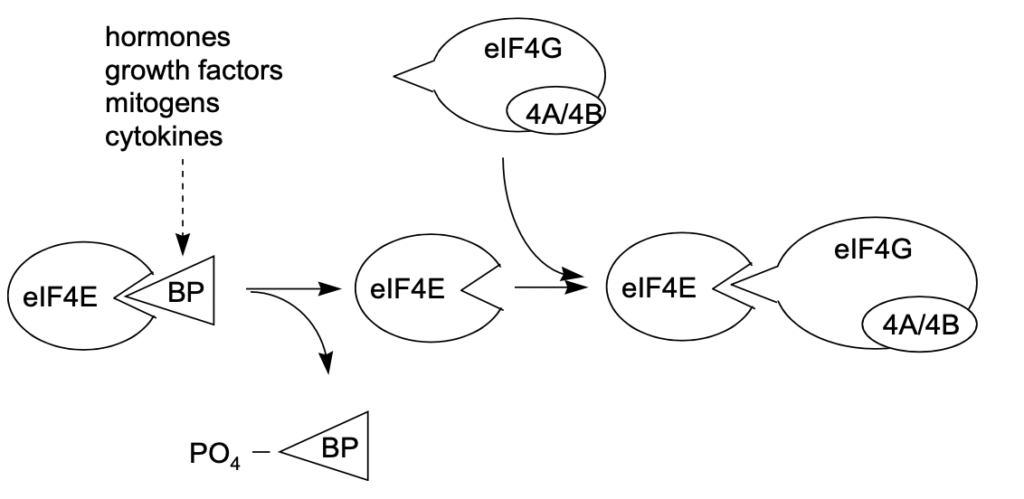
- Eukaryotic initiation factor 4F or eIF4F play important role in regulating initiation of translation. There are many different eukaryotic initiation factors which play important role in translation initiation including eIF4B, eIF2, eIF5, eIF6.
- During translation initiation, elongation competent 80S ribosomes are assembled in which initiation codon is base paired with initiator tRNA in the ribosomal P site. Regulation of protein synthesis majorly takes place during initiation stage.
Role in Regulating Translation Initiation

Figure- Eukaryotic Translation Initiation (Source- Meric F et al, 2002)
- eIF4F delivers mRNA to 43s preinitiation complex. 43S preinitiation complex is formed after eIF2 delivers methionyl charged tRNA to the 40S.
- eIF4F regulates how much of which mRNA gets translated. It is regulated by controlling its subunits which are regulated by phosphorylation and by inhibitor proteins.
Structure of eIF4F
- It consists of three major structures: eIF4E, eIF4A and eIF4G.
eIF4E (24kDa)
- It is the cap binding protein and binds the m7GpppN (7 methyl guanylyl) cap at the mRNA 5’ end. Free eIF4E is present in rate limiting quantities. Increasing the amount of available eIF4E increases the amount of eIF4F, allowing translation of mRNAs with longer 5’UTRs.
eIF4A (50 kDa)
- It is a RNA helicase that helps in unwinding the secondary structure of the mRNA 5’ UTR (Untranslated Region) and uses ATP (an ATPase) for this purpose. This unwinding activity causes it to move in the 5’ to 3’ direction on the mRNA, which is called “scanning”. Its helicase and ATPase activities are stimulated by eIF4B, eIF4H and RNA binding proteins.
- Different mRNAs have different amounts of secondary structure in their 5’ untranslated region which make some mRNAs easier to scan than others and such mRNAs will be more likely to get translated.
eIF4G (220 kDa)
- eIF4G is a high molecular weight peptide that serves as a scaffold and is critical part of eIF4F. It has binding sites for other members of eIf4F: eIF4E, eIF4A, and for poly-A binding protein and ribosome associated eIF43. It is the site of regulation for the assembly of translation initiation complexes. The interaction between eIF4G and eIF3 is required for recruitment of ribosome to the mRNA in mammalian cells and the interaction between eIF4G and poly-A binding protein is required for circularization of mRNA.
- It also has binding site for Mnk kinases (mitogen activated protein kinase interacting kinase). Mnk kinase phosphorylate eIF4E in serine 209.
Regulation of eIF4F subunits by phosphorylation
eIF4E
- Phosphorylation of eIF4E stimulates translation by enhancing its ability to bind with eIF4G. Its ability to bind m7G cap on the mRNA is not affected by phosphorylation.
- Its phosphorylation is stimulated by growth promoting stimuli including growth factors, mitogens, hormones etc. and by cellular stressors like bacterial lipopolysaccharides, tumor necrosis factor and arsenite.
- It is dephosphorylated during heat shock response and hence its activity is downregulated due to HSR.
eIF4E binding proteins (4E-BP)
- eIF4E is inhibited by family of proteins called eIF4E binding proteins or 4E-BP 1,2 and 3. These proteins bind to eIF4E and and prevent it from entering the eIF4F complex.
- They are competitive inhibitors of eIF4E-eIF4G binding. They bind to eIF4E at the same site as eIF4G and prevent the formation of eIF4F when they are active.
- The binding of 4E-BPs to eIF4E is determined by their phosphorylation state. When 4E-BPs are phosphorylated, they do NOT bind to eIF4E. Hence, phosphorylation of the 4E-BP proteins increases protein synthesis.
- Phosphorylation of 4E-BP occurs due to conditions that stimulate cell growth like growth factors, hormones, cytokines via PI3 kinase pathway.

Figure- 4E-BPs are competitive inhibitor of eIF4E.
eIF4G
- The effect of phosphorylation of eIF4G is complex and situational dependent. It depends on cell type, growth condition etc.
References
- Signaling Pathways that Mediate Translational control of Ribosome recruitment to mRNA. Handbook of Cell signaling. 2nd edition. 2010; Pages 2335-2341.
- Jackson RJ et al. The mechanism of eukaryotic translation initiation and principles of its regulation. Nat Rev Mol Cell Biol. 2010; 11(2): 113–127.
- Mahieu HM et al. Molecular Pathways: The eIF4F Translation Initiation Complex—New Opportunities for Cancer Treatment. Clin Cancer Res; 23(1); 21–25.
- Gingras Ac et al. eIF4 initiation factors: effectors of mRNA recruitment to ribosomes and regulators of translation. Annu Rev Biochem. 1999; 68: 913-63.
- https://en.wikipedia.org/wiki/Eukaryotic_initiation_factor_4F.